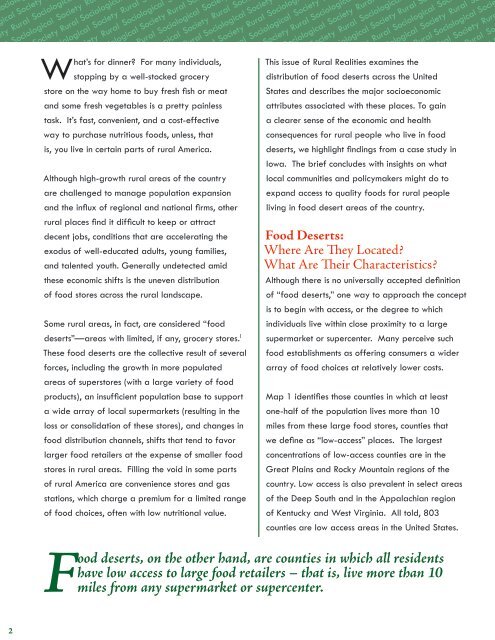Starved for Access: Life in Rural America's Food Deserts
Starved for Access: Life in Rural America's Food Deserts
Starved for Access: Life in Rural America's Food Deserts
You also want an ePaper? Increase the reach of your titles
YUMPU automatically turns print PDFs into web optimized ePapers that Google loves.
ociolog<br />
ical ral SociologicalSocietyRura<br />
iologicalSociety<strong>Rural</strong>Sociological<br />
Society<strong>Rural</strong>SociologicalSociety<strong>Rural</strong>So<br />
y SociologicalSociety<strong>Rural</strong>SociologicalSo<br />
l ical Society<strong>Rural</strong>SociologicalSociety<strong>Rural</strong>SociologicalSociety<br />
ociety<strong>Rural</strong>SociologicalSociety<strong>Rural</strong>SociologicalSociety<strong>Rural</strong>Socio<br />
<strong>Rural</strong>SociologicalSociety<strong>Rural</strong>SociologicalSociety<strong>Rural</strong>SociologicalSociety<br />
ogicalSociety<strong>Rural</strong>SociologicalSociety<strong>Rural</strong>SociologicalSociety<strong>Rural</strong>Sociologic<br />
y SociologicalSociety<strong>Rural</strong>SociologicalSociety<strong>Rural</strong>SociologicalSocietyR<br />
ogicalSociety<strong>Rural</strong>SociologicalSociety<strong>Rural</strong>SociologicalSociety<strong>Rural</strong>Sociological<br />
SociologicalSociety<strong>Rural</strong>SociologicalSociety<strong>Rural</strong>SociologicalSociety<strong>Rural</strong><br />
cal Society<strong>Rural</strong>SociologicalSociety<strong>Rural</strong>SociologicalSociety<strong>Rural</strong>Sociological<br />
ral SociologicalSociety<strong>Rural</strong>SociologicalSociety<strong>Rural</strong>SociologicalSociety<strong>Rural</strong>Soc<br />
Society<strong>Rural</strong>SociologicalSociety<strong>Rural</strong>SociologicalSociety<strong>Rural</strong>SociologicalSocie<br />
SociologicalSociety<strong>Rural</strong>SociologicalSociety<strong>Rural</strong>SociologicalSociety<strong>Rural</strong>So<br />
ty<br />
ociety<strong>Rural</strong>SociologicalSociety<strong>Rural</strong>SociologicalSociety<strong>Rural</strong>SociologicalSocie<br />
S<br />
ologicalSociety<strong>Rural</strong>SociologicalSociety<strong>Rural</strong>SociologicalSocietyRura<br />
iolog<br />
logicalSociety<strong>Rural</strong>SociologicalSociety<strong>Rural</strong>Sociological<br />
y l S<br />
ociologica<br />
o<br />
What’s <strong>for</strong> d<strong>in</strong>ner? For many <strong>in</strong>dividuals,<br />
stopp<strong>in</strong>g by a well-stocked grocery<br />
store on the way home to buy fresh fish or meat<br />
and some fresh vegetables is a pretty pa<strong>in</strong>less<br />
task. It’s fast, convenient, and a cost-effective<br />
way to purchase nutritious foods, unless, that<br />
is, you live <strong>in</strong> certa<strong>in</strong> parts of rural America.<br />
Although high-growth rural areas of the country<br />
are challenged to manage population expansion<br />
and the <strong>in</strong>flux of regional and national firms, other<br />
rural places f<strong>in</strong>d it difficult to keep or attract<br />
decent jobs, conditions that are accelerat<strong>in</strong>g the<br />
exodus of well-educated adults, young families,<br />
and talented youth. Generally undetected amid<br />
these economic shifts is the uneven distribution<br />
of food stores across the rural landscape.<br />
Some rural areas, <strong>in</strong> fact, are considered “food<br />
deserts”—areas with limited, if any, grocery stores. 1<br />
These food deserts are the collective result of several<br />
<strong>for</strong>ces, <strong>in</strong>clud<strong>in</strong>g the growth <strong>in</strong> more populated<br />
areas of superstores (with a large variety of food<br />
products), an <strong>in</strong>sufficient population base to support<br />
a wide array of local supermarkets (result<strong>in</strong>g <strong>in</strong> the<br />
loss or consolidation of these stores), and changes <strong>in</strong><br />
food distribution channels, shifts that tend to favor<br />
larger food retailers at the expense of smaller food<br />
stores <strong>in</strong> rural areas. Fill<strong>in</strong>g the void <strong>in</strong> some parts<br />
of rural America are convenience stores and gas<br />
stations, which charge a premium <strong>for</strong> a limited range<br />
of food choices, often with low nutritional value.<br />
This issue of <strong>Rural</strong> Realities exam<strong>in</strong>es the<br />
distribution of food deserts across the United<br />
States and describes the major socioeconomic<br />
attributes associated with these places. To ga<strong>in</strong><br />
a clearer sense of the economic and health<br />
consequences <strong>for</strong> rural people who live <strong>in</strong> food<br />
deserts, we highlight f<strong>in</strong>d<strong>in</strong>gs from a case study <strong>in</strong><br />
Iowa. The brief concludes with <strong>in</strong>sights on what<br />
local communities and policymakers might do to<br />
expand access to quality foods <strong>for</strong> rural people<br />
liv<strong>in</strong>g <strong>in</strong> food desert areas of the country.<br />
<strong>Food</strong> <strong>Deserts</strong>:<br />
Where Are They Located?<br />
What Are Their Characteristics?<br />
Although there is no universally accepted def<strong>in</strong>ition<br />
of “food deserts,” one way to approach the concept<br />
is to beg<strong>in</strong> with access, or the degree to which<br />
<strong>in</strong>dividuals live with<strong>in</strong> close proximity to a large<br />
supermarket or supercenter. Many perceive such<br />
food establishments as offer<strong>in</strong>g consumers a wider<br />
array of food choices at relatively lower costs.<br />
Map 1 identifies those counties <strong>in</strong> which at least<br />
one-half of the population lives more than 10<br />
miles from these large food stores, counties that<br />
we def<strong>in</strong>e as “low-access” places. The largest<br />
concentrations of low-access counties are <strong>in</strong> the<br />
Great Pla<strong>in</strong>s and Rocky Mounta<strong>in</strong> regions of the<br />
country. Low access is also prevalent <strong>in</strong> select areas<br />
of the Deep South and <strong>in</strong> the Appalachian region<br />
of Kentucky and West Virg<strong>in</strong>ia. All told, 803<br />
counties are low access areas <strong>in</strong> the United States.<br />
<strong>Food</strong> deserts, on the other hand, are counties <strong>in</strong> which all residents<br />
have low access to large food retailers – that is, live more than 10<br />
miles from any supermarket or supercenter.<br />
2
















